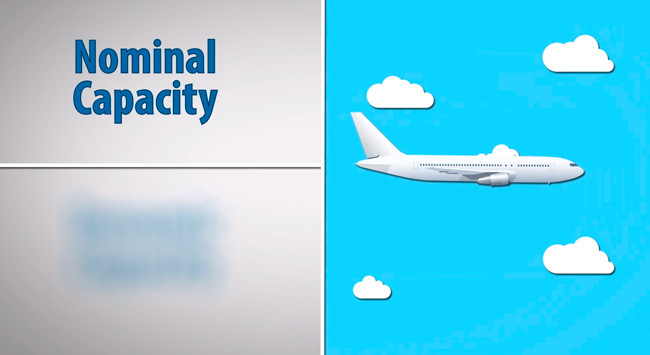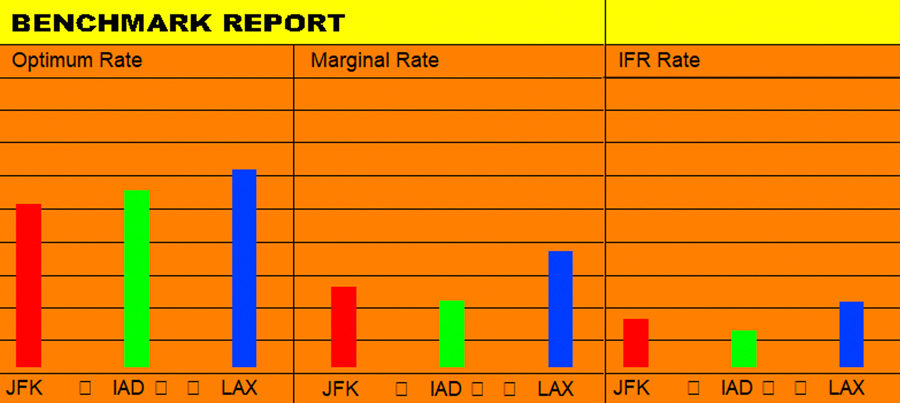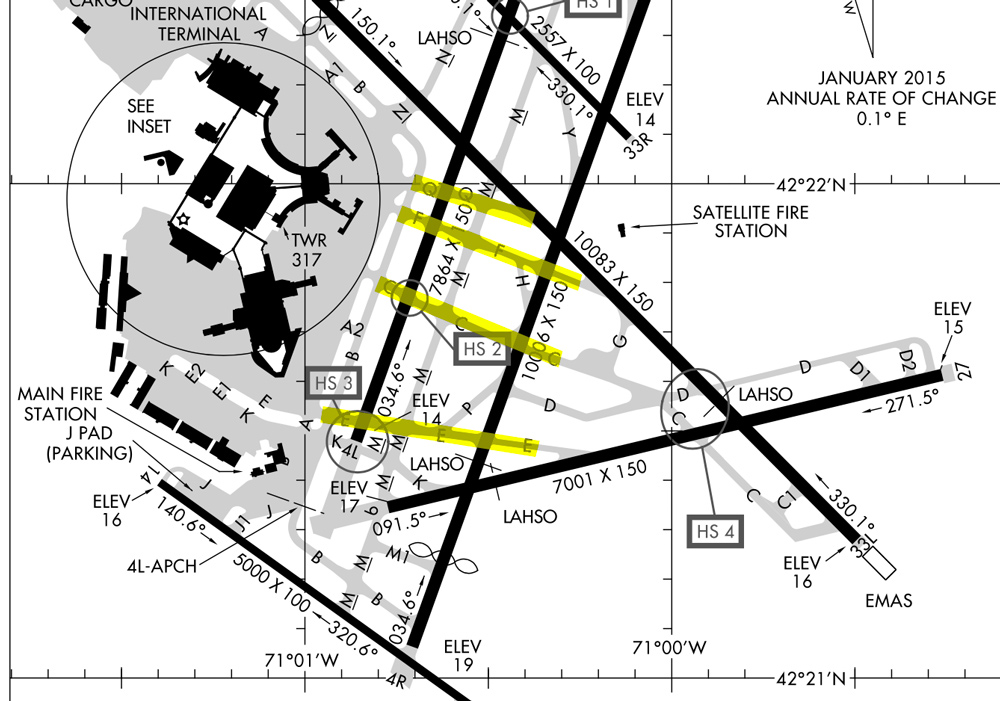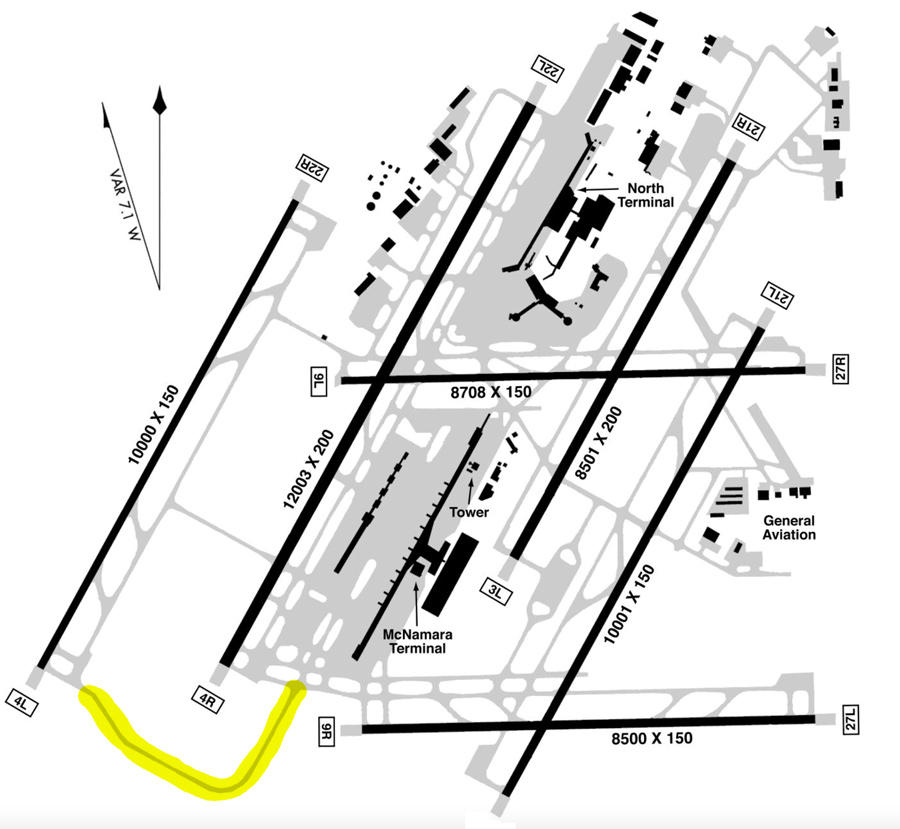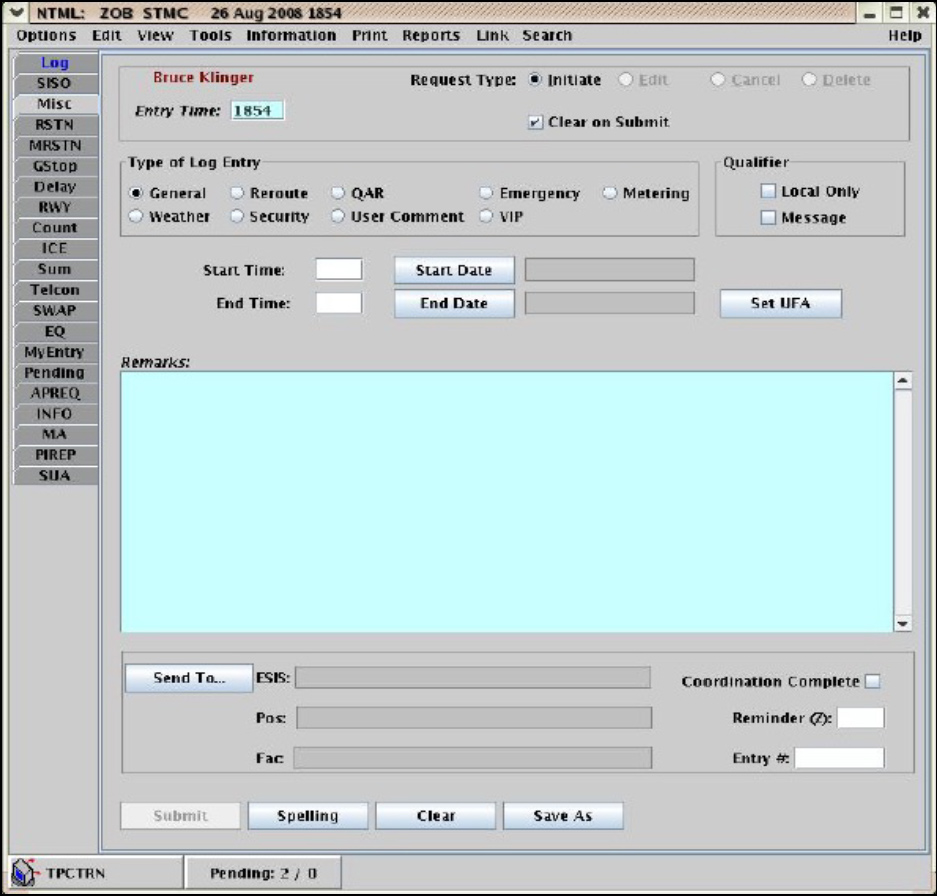Lesson 5: Capacity, Delay, Weather and Contingencies
Introduction
- System capacity is a crucial concept in Air Traffic Flow Management (ATFM).
- Striving to improve system capacity is an integral part of ATFM.
- In this lesson, you will learn the major factors that impact system capacity and how airport and airspace capacities are determined.
- We’ll also discuss the Traffic Management Coordinator’s (TMC) role regarding delays and components of an effective contingency plan.
- Be sure to watch the CADENA contingency planning web-conference at the end of the lesson to see a real-world example of contingency planning.
Lesson Outline
- Airport Capacity
- Airspace Capacity
- Delays
- Contingency Planning
Lesson Objectives
- At the end of this lesson, with references, you will be able to identify and discuss terms and procedures regarding:
- Airport capacity, declared vs. operational.
- Airspace capacity, declared vs. operational.
- Causes for delay.
- Contingency planning.
5.1 Airport Capacity
- Airport capacity is the number of arrivals and departures that an airport can safely handle.
- Airport Capacity = Throughput Rate, i.e. the maximum number of operations that can take place in an hour.

- For State Authorities, governments, and municipalities looking to increase an airport’s capacity, the main strategies include:
- Building new runways.
- Maximizing the efficiency of existing runways.
- Maximizing the efficient use of departure and arrival corridors into and out of the airport.
- NOTE: “Systems Thinking” viewpoint: This could entail changes in the surrounding airspace or procedures.
- Planners use a benchmark analysis study to calculate the rates. Internationally, we refer to this type of calculation as “declared capacity.” In other words, it is static and categorized. Later in this lesson, we will discuss “operational capacity,” which is different.
Capacity Benchmark Analysis
Benchmark or “declared” capacity determinations for an airport:
- Optimum rate = the maximum number of aircraft that can be “routinely handled” using:
- Visual approaches during periods of unlimited ceiling and visibility.
- No traffic constraints in the en route system or airport vicinity.
- Visual Flight Rules (VFR).
- Marginal rate = periods when the weather is not good enough for visual approaches, but is still better than instrument conditions.
- IFR rate = the number of aircraft that can be handled during:
- Peak periods of poor visibility when radar is required to ensure separation between aircraft.
- Specified runway configurations, often used in adverse weather.
- Instrument Flight Rules (IFR) conditions.
Sample Airport Capacity Comparisons:
Benchmark/Declared Capacity
- Based on airport observations by experienced air traffic controllers and computer calculations of airfield capacity, the U.S. developed benchmark airport capacity rates with the following considerations. These are considered the critical inputs to the benchmark/declared capacity analysis.
- Demand characteristics
- Fleet mix
- Runway dependencies
- Weather conditions
- Runway configurations
- Approach speeds
Airport Design and Efficient Movement
- An airport’s structure can greatly impact its capacity. For example, both Boston airport (BOS) and Detroit airport (DTW) have six runways. However, the Optimum Rate for BOS is 59, while the Optimum Rate for DTW is 92.
- Like many older airports, BOS was not designed with large jet airplanes in mind. It has many taxiway crossings that cross runways on the field. (See image below.) This design can hinder a jet’s ability to quickly accelerate from idle to high thrust, which takes time from other aircraft operations using the runway. As a result, the airport’s arrival rate (AAR) is lower, potentially stunting demand growth over the airport’s lifespan.
- DTW, on the other hand, has a runway configuration of four parallel and two crosswind runways with an end-around taxiway* (See image below.) The end-around taxiway was built to allow airplanes to access runway 4L without hindering operations.
- For State Authorities, governments, and municipalities looking to increase an airport’s capacity, newly designed airports or runway construction may be a consideration.
Operational Capacity
- Operational Capacity or “tactical capacity” is the capacity number that can change several times a day as conditions and constraints to the system occur.
Determining Operational Capacity
- A TMC's role is to recognize conditions which will impact airport capacity and adjust the flow as necessary. Conditions that could impact operational capacity include:
1. Runway configuration
- Most airports are designed around primary wind direction.
- Taxi routes and ramp configurations are built around the primary, or most common, configuration.
- Approaches, departure procedures, and arrival procedures are normally built to favor a primary direction or configuration.
- Runway changes occurring during peak periods can result in major congestion.
- Runway changes can result in less desirable and less advantageous instrument procedures or runway intersection combinations.
- Some airlines request to use the best configuration regardless of wind less than 10 knots to avoid congestion and delays.
- Runway configuration can also mean wake turbulence restrictions.
- Different configurations can have a tremendous impact on the application of wake turbulence rules, i.e., heavy jet or B757 operations.
2. Arrival/departure mix
- Heavy concentration of arrivals or departures can change the traffic flow of the airport.
- Departures can back up on taxiways and gates causing movement problems for arrivals and requiring them to hold outside of gateways.
- Arrival sequencing might be increased to allow for longer runway times and alternative taxiway usage; runway crossing can become a problem.
3. Noise abatement
- An airport may not open until 0700, at which time aircraft are in a queue.
- ACC TMCs may impose in-trail restrictions or other initiatives to prevent chaos.
- Runway use programs can require tailwind operations—increasing runway occupancy times.
4. Weather conditions approaching the airport
- At large airports, there can be a wide variation in conditions from one side of the airport to the other.
- Variations can cause fix-balancing problems; since one side is marginal and backing up while the other side (of the airspace) is VFR free-flow.
- Thunderstorm activity can close one or multiple runways.
- Simultaneous instrument approaches susceptible to turbulence, wind shear, crosswinds, etc.
5. Weather conditions at the airport
- Low visibility slows everything down, especially when the tower cannot see aircraft exiting the runway.
- Fluctuating visibility situations require close coordination between Tower and ACC TMCs.
- Rain, ice, and snow are runway contaminants that can severely reduce arrival rates.
- When the visibility is low due to fog minimums, approach control may significantly reduce the number of arrivals it will accept.
6. Equipment outages
- Runway lighting, approach lighting, navigational aids (NAVAIDs), radar, etc.
7. Air shows
- Loss of runways and/or airspace blocks for air shows and demonstrations can temporarily impact capacity.
- Generally, large amounts of arrivals and departures before and after the events cause artificially high volumes of traffic.
- Normal traffic can suffer due to air show activities.
8. Construction
- Airport construction may close runways, taxiways, ramps, etc. Each closure is a modification to the flow rate and may change the Airport Acceptance Rate (AAR).
- Construction near the airport may affect capacity too. For example, a crane off the approach end of a runway may raise minimums to VFR only or prohibit all usage.
Determining and Communicating Operational Capacity
- Through experience, a TMC can formulate a good idea of exactly how many arrivals and departures an airport can handle at any given time.
- If the TMC can combine the structural design of the airport, the potential impacts discussed above, and some benchmark analysis numbers, they can come up with an operational airport arrival rate (AAR) and an airport departure rate (ADR).
- Airport Acceptance Rate (AAR) is a dynamic input parameter specifying the number of arriving aircraft an airport or airspace can accept per hour. This is also referred to as Operational Arrival Capacity.
- The AAR is used to calculate the desired interval between successive arrival aircraft.
- The Tower/TMA TMC sets the AAR based on the conditions described above (winds, weather, airspace limitations, airport, fleet mix, etc.) plus the experience level of the controllers / TMC.
- Airport Departure Rate (ADR) is also a dynamic parameter. It specifies the number of aircraft which can safely depart and enter the surrounding airspace per hour.
- Communicating AAR/ADR rates is crucial. The FAA communicates a variety of ATFM information to facilities and stakeholders via its National Traffic Management Log (NTML). This electronic system transmits any change in AAR/ADR (actual arrival and departure rates) on a real time basis.
5.2 Airspace Capacity
- Airspace Nominal Capacity is the maximum demand per hour a controller can safely handle in a particular sector.
- Airspace capacity within the terminal maneuvering area (TMA) can have a direct effect on the Airport Arrival Rate (AAR) by limiting the number of aircraft the TMA can accept and get to the airport.
- Airspace capacity constraints must be evaluated constantly to set an Airspace Dynamic Capacity. We’ll discuss that later in this lesson.
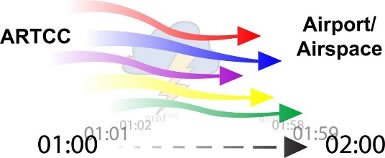
Enhancing Airspace Nominal Capacity
- For State Authorities, governments, and municipalities looking to enhance airspace nominal capacity, the main strategies include:
- Redesign the airspace.
- Re-stratify sectors, potentially creating additional sectors.
- The number of operable sectors, along with their shapes and vertical separations, strongly affect the capacity of the ATM system.
- Re-design air route networks
- The en route and TMA Routes Network should be designed to fit several factors, such as traffic complexity, operational procedures, Performance Based Navigation (PBN) * operations, design of the ATC sectors, and joint management of traffic volume with adjacent ATC Units.
- In the oceanic and offshore airspace, procedural and technological changes offer opportunities to realign airspace and flows.
Example of an Airspace Redesign
The diagrams below show an example of an airspace redesign to increase airspace capacity. Mexico MTY ZMO increased its nominal throughput by redesigning the airspace from four sectors to five.
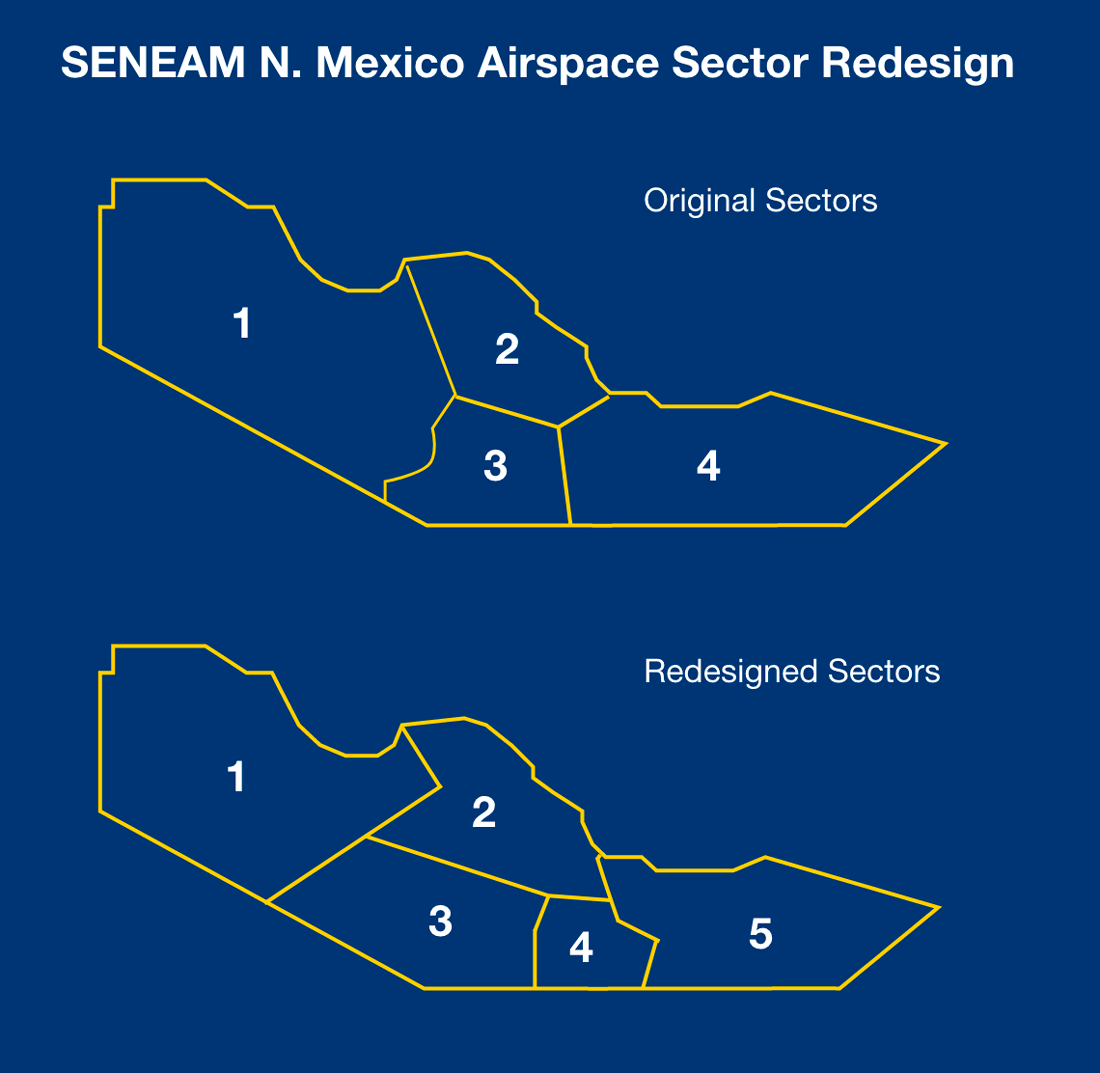
Important Considerations
- To achieve maximum benefits from an airspace redesign, there are important considerations, such as controller training, operational roles, and procedures.
- Controllers may need training to become proficient with the revised airspace working environment.
- Dedicated roles, such as arrival movements coordinator or multi-sector planner/coordinator may help to smooth traffic flows.
- ATC procedures may need to be updated or realigned to fit the new airspace configuration.
- Some examples of ATC procedures that, if properly tailored, can enhance airspace capacity include:
- Wake Turbulence Grouping (WTG): If arrivals and departures are sequenced according to wake turbulence category, the additional separation behind heavier aircraft can be avoided, enabling higher throughput. This technique is particularly effective when used for traffic approaching a runway dedicated exclusively for either take-off or landing traffic, or during peak periods of arrivals to a runway used for mixed mode (arrival and departure) operations.
- Runway Optimization: In cases of mixed mode runway operations, giving priority to departures or arrivals, depending on demand, may help to optimize airspace.
- Minimum Authorized Spacing: Applying the minimum authorized spacing between aircraft on final approach will ensure that capacity is not wasted. To consistently achieve minimum spacing, the runway mode of operation and the prevailing traffic must be taken into account. For example, runways used for only arrivals, only departures, or mixed use, all have differing rules which can be taken into account while tallying nominal capacity. Communicating Rapid Exit Taxiway (RET) numbers and positioning during the final approach supports reduced separations as well.
- Time Based Separation on Final Approach: Under historical final approach systems of fixed-distance separation, aircraft groundspeed drops when headwinds increase. This reduces the landing rate, which in turn leads to extended airborne holding and increased delays. Time Based Separation dynamically adjusts the separation between arrivals, maintaining the time separation between aircraft at a constant equivalent to the distance separation required. This safely reduces approach separation to recover most of the capacity otherwise lost during strong headwind conditions.
- Speed Control: Speed control is essential for the optimum use of the runway and available airspace as well as to enable terminal area and aerodrome controllers to accurately assess the intervals between aircraft. Use of standard speeds aids efficiency and removes unpredictability for both pilot and controllers. Policy to support this initiative and related to aircraft performance, poor performing aircraft may be held outside of peak periods.
- Flight Specific Arrival Runways: Assigning a specific runway according to the parking stand position, or to the airline preferences, can significantly smooth subsequent ground movement once the flight has landed. However, this initiative can complicate air traffic management while airborne, so the overall best effect on capacity should be used.
- Aircraft specific Standard Instrument Departures (SIDs): Instructing departing aircraft to turn away from runway heading as soon as possible after take-off allows the number of subsequent departures in a given period to be maximised. SIDs should be designed with tracks diverging as soon as possible after departure. SIDs may be developed for aircraft meeting specified noise level requirements and/or light aircraft, facilitating their speedy departure. These may be used in conjunction with early turn departure and visual separation techniques.
- Military Operations: The ANSP and the Military Authority should set a mutual agreement on procedures and airspace usage. It is recommended to keep most of the military training activities within the limits of Temporary Segregated Areas (TSA) and Temporary Restricted Areas (TRA). This would allow proper activation planning and to distribute advance information daily. Non-aviation military activities should take place in published danger areas, rarely affecting civil traffic flows. It is also recommended to apply the Flexible Use of Airspace (FUA) Concept, thus allowing preparation of a daily airspace use plan at pre-tactical level. The actual activation and deactivation of areas is then done on the day of operations at a tactical level. Besides the permanent routes, several conditional routes should be defined to be then managed in daily plans whenever there is a military exercise within danger areas.
The ATM Automation System: Automation, when designed to support the specific ANSP Concept of Operations, can help improve overall capacity. It helps by reducing controller workload, which improves sector capacity. The ATM Automation system should also support a comprehensive exchange of information both among its internal components and to/from external entities.
Dynamic Airspace Capacity Factors
Many factors can dynamically affect airspace capacity such as:
- Weather – en route or at the airport
- Noise mitigation
- Temporary flight restrictions
- Sectorization
- Air shows
- Weather
- Convective weather can cause excessive volume during deviations.
- Airport weather can cause airborne holding issues.
- Noise mitigation
- Noise mitigation during peak periods can impact traffic flow as congestion builds.
- Noise mitigation can increase airborne complexity as aircraft are vectored to meet noise restrictions.
- Temporary Restrictions
- Temporary Restrictions, used for events like fires, aircraft accidents, and sporting events, can increase complexity by requiring vectors around an area.
- Temporary Restrictions close to an airport may close runways.
- Sectorization
- The goal of sectorization is to reduce coordination, but it can become a hindrance as well.
- Complex configurations can cause excessive vectoring for altitude, etc.
- Air shows
- Air shows can impact capacity by closing airspace blocks used for demonstrations, etc.
- A large inflow and outflow of aircraft before and after an air show can cause artificially high volumes of traffic and unexpected traffic flows.
For more information, see the Manual on Global Performance of the Air Navigation System (Doc 9883)
5.3 Delays
- Delay = Any ATFM measure, tactical or preplanned, implemented to distribute demand, maintain safety, and manage delay. The goal is to distribute delays equitably and listen to the input from stakeholders as much as feasible.
- Delays reflect ATFM system performance, so it’s important to measure delays on a regular basis.
- TMC duties regarding delays include:
- Implementing the least restrictive TMM possible.
- Canceling TMMs in a timely manner to avoid unnecessary delays.
- Planning, coordinating, and communicating as able to minimize delays.
- The FMU should:
- Update and ensure the accuracy of information on the CADENA Operational Information System (OIS) web page.
- NOTE from FAA 7210.55 order:
The FAA keeps track of delays if they are greater than 15 minutes and are caused by certain impacting conditions.
Conditions that Cause Delays
The key factors that cause delay include:
1. Weather
- Thunderstorms, hurricanes, tornados, and runway treatments.
- Wind that causes less than optimum runway configuration, wind shear, or other adverse conditions.
2. Equipment
- An equipment failure or outage, which causes a reduced capacity at the facility, whether at an airport or en route.
- When there is an outage rather than a failure, try to identify whether the outage was scheduled or unscheduled.
3. Runway/taxiway
- Existing runway(s) and/or taxiway(s) limitations.
- Disabled aircraft impeding the optimal use of runway(s) or taxiway(s).
- Runway construction, maintenance, obstruction.
- Configurations that benefit one airport but create less than optimum capacity at a nearby airport.
4. Noise abatement
- Reduced capacity from runway and route restrictions designed to reduce noise in communities near airports.
5. Runway changes
- Operational Advantage = When there are multiple airport terminal areas close to each other, a runway configuration change made to increase airport capacity at one airport can create less than optimum capacity at a secondary airport.
- Operational Necessity = When less than optimum runway configuration is required for overall traffic flow benefits to neighboring facilities.
- Runway construction, maintenance, obstruction.
6. Volume
- Delays due to multi-taxi and compacted demand.
- Multi-taxi = congestion is caused by many aircraft trying to taxi at once.
7. Other conditions include:
- Air show.
- Aircraft emergency.
- Aircraft radio.
- Aircraft stuck mike.
- Bird strike.
- Bomb threat.
- External Radio Frequency Interface (RFI).
- Fire.
- Flight check.
- International restrictions.
- Military operations.
- Non-radar procedures.
- Security – This would include delays attributed to the preservation of safe air travel.
- VIP movement.
5.4 Contingency Planning
- What happens when there is a major disruption to your airspace or an airspace near you? How do you get back to normal?
- ATFM Contingency Plans provide answers to these questions with procedures for managing emergency and out-of-the-ordinary situations. No plan can cover all circumstances but having a contingency plan in place provides a starting point and improves our ability to handle emergency conditions.
- ATFM Contingency Planning is collaborative decision making (CDM) for adverse conditions. (ICAO Doc 9971)
- FMUs, Supervisors, and TMCs may all be involved in facilitating ATFM contingency plans from the first hint of trouble to the end of the event and restoration of normal services.
- For this reason, TMCs need to be knowledgeable about, and comfortable with, the contingency plans in their facilities, as well as any existing plans affecting the regional airspace system. For example, what would a TMC do if the FMU had to close down or evacuate?
- Knowing what to do when things go wrong is an important part of a TMC’s comprehensive knowledge about ATFM and the Air Traffic System as a whole. This broader view is different than controllers who focus on specific airspace sectors and areas of specialty.
ATFM and Contingency
- ATFM and contingency arrangements are closely interlinked:
- ATFM provides a process for mitigating the effects of disruptions in an ATM system.
- ATFM contingency plans are designed to address disruptions in capability that impact demand and capacity imbalances of the ATM system.
- Effective ATFM contingency plans are written, published, periodically reviewed, and part of regular training.
- ATFM contingency plans contain:
- A description of potential events that can disrupt air traffic operations.
- The ATFM measures to be taken in response to the disruptions.
- A process for applying ATFM measures during each contingency situation.
- Recovery procedures.
- Information on contingency points of contact, roles, and responsibilities.
- Post-contingency reporting procedures.
- ATFM contingency plan topics may include:
- ACCs
- Evacuation
- Radar failure
- Air/Ground (A/G) communication failure
- Power failure
- Flight data processing system (FDPS) failure
- Staffing shortages
- Severe weather / natural phenomena
- Hurricanes / tropical storms
- Volcanic eruption
- Earthquakes
- Airports
- Aircraft accidents / incidents
- ATFM system unavailability
- Includes predetermined procedures that define reduced capacities on major traffic flows; these are applied via local ATFM measures (TMMs) in the event of such outages.
- FMU outages
- Equipment failure
- FMU services not available
- Once enacted, ATFM contingency plans become an important part of the ATFM infrastructure. They are a crucial component of the ATFM system.
- The CANSO ATFM Data Exchange Network for the Americas (CADENA) has developed tools to help communicate ATFM and contingency planning, including the following:
- CADENA weekly ATFM planning web-conferences
- CADENA Operational Information System (OIS): https://www.cadenaois.org
The CADENA web-conferences are designed to bring all affected Aviation Navigation Service Providers (ANSPs) and stakeholders together to provide common situational awareness of the adverse condition and how it will impact air traffic.
At first knowledge of an impending contingency event, these planning web-conferences may occur daily. As necessary, the frequency may increase to every few hours or as stakeholders request information.
Usually, the web-conferences are hosted by one ANSP who acts as the moderator.
The attendees can include FMUs, ATC facilities, airlines, airports, and meteorologists. The web-conference may begin with introductions so everyone knows who is on the call. It may also include slides containing maps and diagrams to show expected impact areas. Usually, all stakeholders are invited to ask questions.
- Here's an example of a CADENA contingency planning web-conference that happened prior to category 5 Hurricane Irma in 2017.
- As you watch the video, you will hear FIRs discuss current status and contingency plans. For example:
- Miami Center asks Punta Cana Tower to verify if they are still planning on closing at a certain time.
- As a contingency plan, controllers from ZSU (San Juan) are being relocated to ZMA (Miami Center), but “limited ATC services” is still expected.
- Piarco ANSP states they will publish routes around ZSU (San Juan) on the CADENA OIS and in an email.
- Having an ATFM contingency plan in place prevented ZSU (San Juan) from over restricting inbound aircraft.
- Additional adverse conditions to consider when developing contingency plans include:
- Airport Customs
- Airport Security
- Airport and Airline personal
- Disaster recovery assistance
- Fuel availability
In this lesson, you learned:
- Airport capacity is the maximum number of arrivals or departures that can be safely handled by an airport.
- Airspace capacity is the maximum demand per hour a controller can safely handle in a particular sector.
- Benchmark or declared capacity is static; operational capacity or “tactical capacity” can change throughout the day as conditions and constraints occur.
- In ATFM, delay means an ATFM measure, tactical or preplanned, implemented to distribute traffic demand, maintain safety, and spread delay equitably.
- Contingency plans provide procedures for managing emergency and out-of-the-ordinary situations; improving our ability to handle crisis conditions.
Lesson 5 Knowledge Check
 Lesson 5 Knowledge Check Matching Quiz
Lesson 5 Knowledge Check Matching Quiz Lesson 5 Knowledge Check Multiple Choice
Lesson 5 Knowledge Check Multiple Choice